The 64 Core Threadripper 3990X CPU Review: In The Midst Of Chaos, AMD Seeks Opportunity
by Dr. Ian Cutress & Gavin Bonshor on February 7, 2020 9:00 AM ESTAMD 3990X Against $20k Enterprise CPUs
For those looking at a server replacement CPU, AMD’s big discussion point here is that in order to get 64 cores on Intel hardware is relatively hard. The best way to get there is with a dual socket system, featuring two of its 28-core dies at a hefty $10k a piece. AMD’s argument is that users can consolidate down to a single socket, but also have better memory support, PCIe 4.0, and no cross-memory domain issues.
| AMD 3990X Enterprise Competition | |||
| AnandTech | AMD 3990X |
AMD 7702P |
Intel 2x8280 |
| SEP | $3990 | $4450 | $20018 |
| Cores/Threads | 64 / 128 | 64 / 128 | 56 / 112 |
| Base Frequency | 2900 | 2000 | 2700 |
| Turbo Frequency | 4300 | 3350 | 4000 |
| PCIe | 4.0 x64 | 4.0 x128 | 3.0 x96 |
| DDR4 Frequency | 4x 3200 | 8x 3200 | 12x 2933 |
| Max DDR4 Capacity | 512 GB | 2 TB | 3 TB |
| TDP | 280 W | 200 W | 410 W |
Unfortunately I was unable to get ahold of our Rome CPUs from Johan in time for this review, however I do have data from several dual Intel Xeon setups that I did a few months ago, including the $20k system.
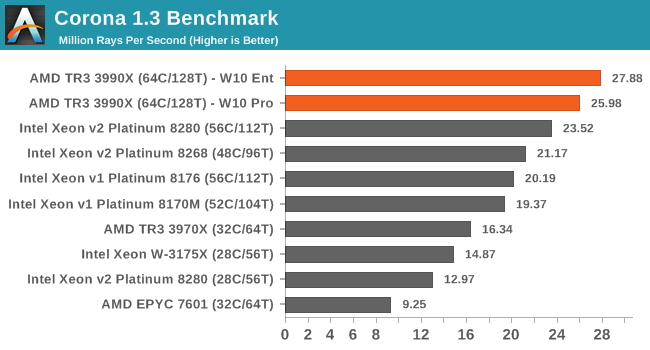
This time with Corona the competition is hot on the heels of AMD's 64-core CPUs, but even $20k of hardware can't match it.
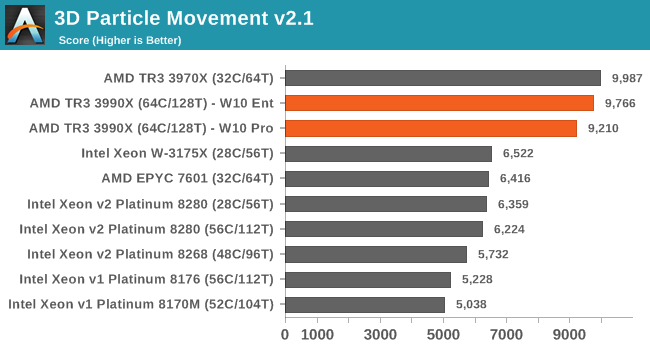
The non-AVX verson of 3DPM puts the Zen 2 hardware out front, with everything else waiting in the wings.
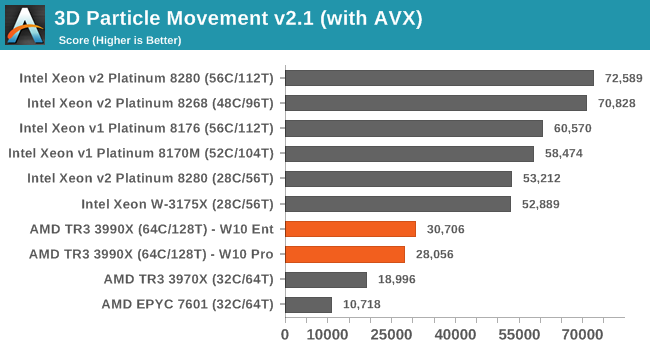
When we add in the AVX-512 hand tuned code, the situation flips: Intel's 56 cores get almost 2.5x the score of AMD, despite having fewer cores.
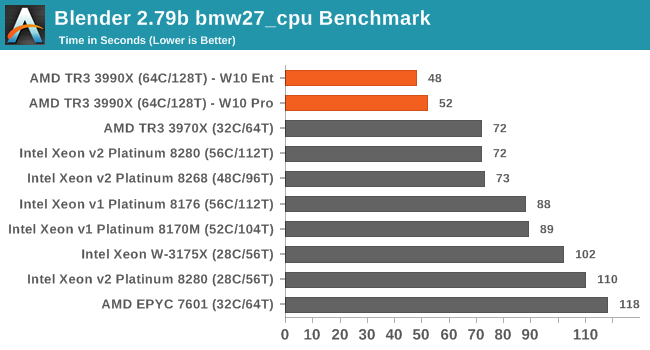
Blender doesn't seem to like the additional access latency from the 2P systems.
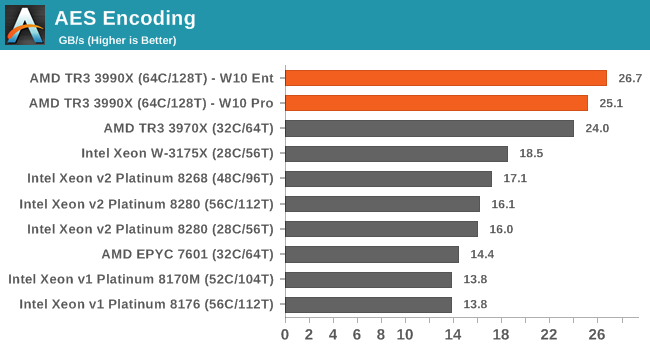
For AES encoding, as the benchmark takes places from memory, it appears that none of Intel's CPUs can match AMD here.
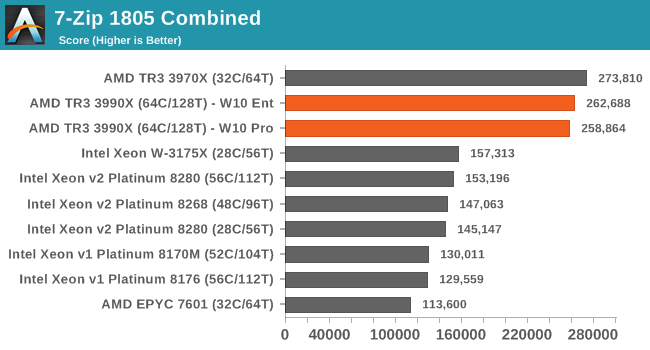
For the 7-zip combined test, there's little difference between AMD's 32-core and 64-core, but there are sizable jumps above Intel hardware.
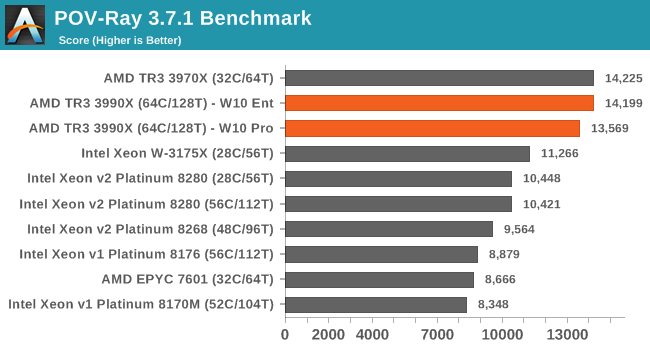

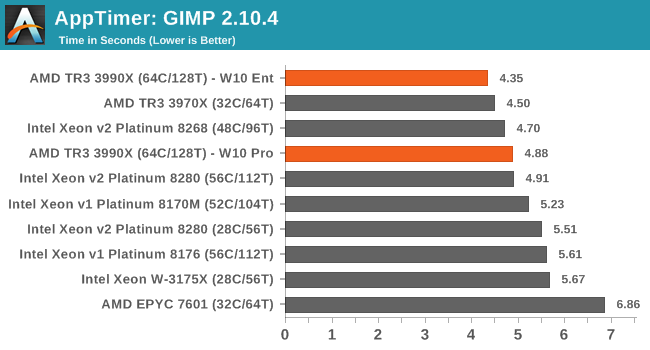
Verdict
In our tests here (more in our benchmark database), AMD's 3990X would get the crown over Intel's dual socket offerings. The only thing really keeping me back from giving it is the same reason there was hesitation on the previous page: it doesn't do enough to differentiate itself from AMD's own 32-core CPU. Where AMD does win is in that 'money is less of an issue scenario', where using a single socket 64 core CPU can help consolidate systems, save power, and save money. Intel's CPUs have a TDP of 205W each (more if you decide to use the turbo, which we did here), which totals 410W, while AMD maxed out at 280W in our tests. Technically Intel's 2P has access to more PCIe lanes, but AMD's PCIe lanes are PCIe 4.0, not PCIe 3.0, and with the right switch can power many more than Intel (if you're saving 16k, then a switch is peanuts).
We acknowledge that our tests here aren't in any way a comprehensive test of server level workloads, but for the user base that AMD is aiming for, we'd take the 64 core (or even the 32 core) in most circumstances over two Intel 28 core CPUs, and spend the extra money on memory, storage, or a couple of big fat GPUs.










279 Comments
View All Comments
msroadkill612 - Sunday, February 9, 2020 - link
It has long puzzled me, that debate seems premised on unchangeable software, when of course few things are more readily changed.To say little software uses 128 threads is hardly surprising, when it is such a large increase to an unprecedented level.
Even if the extra threads have limited current utility, surely they are nice reserve resources to have as a likely upgrade path.
nt300 - Sunday, February 9, 2020 - link
You need to bring the Cores to market to push software developers into utilizing such horse power. Intel won't do that, because they rather overcharge for very little where as AMD has the upper hand and can add as many cores as possible. More Cores is where AMD can compete in, on top of providing a much better micro architecture.msroadkill612 - Monday, February 10, 2020 - link
my fault not making my point better - this is but one example of the mindset i refer to. "current benchmarks show x better than y, so buy x", even when y has far better fundamentals and its a very dynamic ecosystem.PCIE 4 gpu is a current maddening example. It is barely mentioned when comparing a multi year life span product (nvidia vs navi on x570) for an ecosystem clearly headed for exceeding current gpu cache levels.
dwade123 - Monday, February 10, 2020 - link
64 cores of uselessness is only good for servers. There ain't gonna be time for future software to make use of 128 threads either because tomorrow's software will shift to the GPU for AI and superior performance.msroadkill612 - Tuesday, February 11, 2020 - link
You mean like "nobody needs more than 4 cores"?Never say never.
nt300 - Sunday, February 9, 2020 - link
Once again AMD demonstrates aggressive innovation & technological advancements. Now that a set of ZEN engineers moves over onto the RTG, can't wait to see how well they fair with the RDNA2 enhancements.Redstorm - Monday, February 10, 2020 - link
It blows me away as a technologist that you tested this on Windoz, Unlock the potential with a true performance OS like Linux29a - Friday, February 14, 2020 - link
It blows me away that you consider yourself an expert but use the term Windoze. I bet you use M$ too.msroadkill612 - Monday, February 10, 2020 - link
Intuitively, turning off SMT seems an attractive option for many - for now anyway. For an extra $2k, you turn 64 threads into 64 cores, avoid some software issues & presumably get better utility from expensive memory.Silma - Monday, February 10, 2020 - link
Can we still categorize a processor purchase as "Enthusiast" when it costs $3,990 ?Especially when the only reason to purchase it is 3D rendering?
I don't think so. We need a new category and it's probably "Pro 3D renderer".